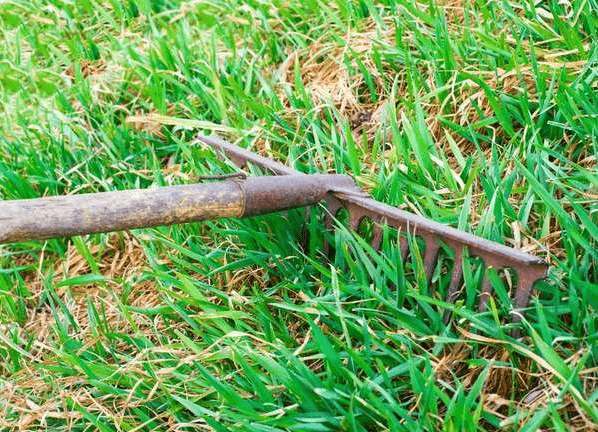Dethatching is an essential practice for maintaining healthy green lush grass. While thatch is good for lawns, too much of it can prevent nutrients, air, water, and sunlight from properly reaching the grass roots and blades.
Thatch is a naturally occurring layer of leaves, roots, rhizomes, and other organic debris between the base of the grass blades and the soil.
A thin layer of thatch usually about ½ inch thick is good for a healthy lawn. It reduces soil compaction, and loss of water prevents weeds and maintains optimum temperature for good growth of grass.
Thatch becomes a problem when it builds up faster than it can decompose. If the layer becomes more than ½ inch, thatch will prevent grass access to water, air, nutrients, and sunlight at the root level.
Additionally, a thick layer of thatch can harbor disease-causing fungi and insects. One sign that your lawn needs dethatching is when the grass starts turning yellow, the lawn feels spongy, and when you have difficulty moving a lawn mower.

What causes thatch buildup?
Excessively thick thatch is caused by the following:
- Excessive watering and fertilization with nitrogen increases the growth rate of grasses as compared to the breakdown of dead grass
- Mowing the grass too high or not collecting grass clippings after cutting the grass
- Heavy and compacted soil with a poor flow of water and air
- Excessive use of pesticides and fungicides that kill or impede microorganisms such as earthworms which break down organic matter.
- Some types of grasses such as Bermuda and Kentucky bluegrass grow and spreads faster thus prone to thatch.
How to know if your lawn needs dethatching
To figure out if your turf needs dethatching, here is what to do:
- Walk across your lawn and feel the touch underfoot. The lawn will feel bouncy or spongy if there is a thick layer of thatch.
- After mowing or cutting off the top green grass, a lawn with thatch buildup will appear brown or yellowish.
- Use a trowel to extract a small section of your turf about 3 inches thick. Take a look and measure, if the thatch has extended more than ½ inch. If so, it’s time to start planning for the removal of the thatch.
When to dethatch your lawn
A healthy lawn should be dethatched at least once per year. However, timing is important in this gardening practice. You should dethatch a lawn only when the weather conditions are favorable for rapid recovery of the grass.
Cool-season grasses are best dethatched in late August to early October. This is the time when the grasses are growing optimally with less interference from weeds.
Warm-season grasses on the other hand should be dethatched in late spring or around the end of March to early April.
Do not dethatch during summer or winter when the grass is dormant. The process tears and rips dormant turf and this can affect its ability to recover.
How to dethatch a lawn
Dethatching is done using special tools or equipment depending on the thickness of the thatch and the size of the lawn as well. Ideally, for a perfect outcome, hiring a professional would be the best option. If you want to do it yourself, begin by mowing down your lawn.
For a small lawn, with a little amount of thatch, using a manual dethatching rake is recommended. This is a special tool with curved spikes designed to dig into the lawn and pull up thatch as you rake.
A power rake may also be used but only on strong grass that can withstand the commotion.
For thick layers of thatch, vertical mowers are used to pull the thatch up from the turf and often along with grassroots to the surface. The blades or spikes may be adjusted to control the amount of thatch being removed.
What to do after dethatching
Dethatching takes a toll on a lawn and your grasses will appear messy. This is why it ought to be carried out when the grass is strong and healthy. To speed up the recovery of your lawn, remove all the debris and give it a good watering on a regular basis.
With dethatching done, this is the most ideal time to overseed your lawn if you want to have that carpet of thick lush green grass.
Dethatching vs Aerating
While dethatching is the removal of a layer of organic matter from underneath the grass blades, lawn aerating involves punching small multiple holes in a lawn using a special tool so that nutrients, water, and air can reach the grass root.
Both practices help enhances deep-root growth and the growth of lush green grass.
Heavy or compacted soil needs to be aerated annually to loosen up the soil and promote root growth. To prevent future thatch buildup, strictly fertilize a lawn based on recommended soil tests. Follow the right mowing practices and water wisely.